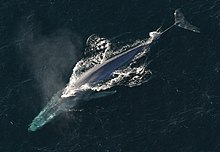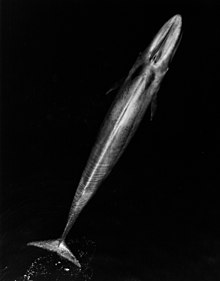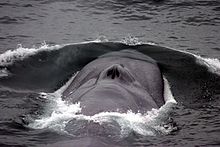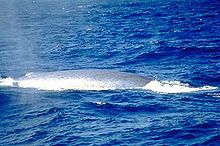| Blue whale[1] | |
|---|---|
 | |
| Adult blue whale (Balaenoptera musculus) | |
| Size compared to an average human | |
 | |
| Blue whale range (in blue) |
The blue whale (Balaenoptera musculus) is a marine mammal belonging to the baleen whales (Mysticeti).[3] At up to 29.9 metres (98 ft)[4] in length and with a maximum recorded weight of 173 tonnes (190 short tons)[4] and probably reaching over 181 tonnes (200 short tons), it is the largest animal known to have ever existed.[5][6]
Long and slender, the blue whale's body can be various shades of bluish-grey dorsally and somewhat lighter underneath.[7] There are at least three distinct subspecies: B. m. musculus of the North Atlantic and North Pacific, B. m. intermedia of the Southern Oceanand B. m. brevicauda (also known as the pygmy blue whale) found in the Indian Oceanand South Pacific Ocean. B. m. indica, found in the Indian Ocean, may be another subspecies. As with other baleen whales, its diet consists almost exclusively of small crustaceans known as krill.[8]
Blue whales were abundant in nearly all the oceans on Earth until the beginning of the twentieth century. For over a century, they were hunted almost to extinction by whalers until protected by the international community in 1966. A 2002 report estimated there were 5,000 to 12,000 blue whales worldwide,[4] in at least five groups. The IUCN estimates that there are probably between 10,000 and 25,000 blue whales worldwide today.[9] Before whaling, the largest population was in the Antarctic, numbering approximately 239,000 (range 202,000 to 311,000).[10] There remain only much smaller (around 2,000) concentrations in each of the eastern North Pacific, Antarctic, and Indian Ocean groups. There are two more groups in the North Atlantic, and at least two in the Southern Hemisphere. As of 2014, the Eastern North Pacific blue whale population had rebounded to nearly its pre-hunting population.[11]
...
Description
Description
The blue whale has a long tapering body that appears stretched in comparison with the stockier build of other whales.[24] The head is flat, U-shaped and has a prominent ridge running from the blowhole to the top of the upper lip.[24] The front part of the mouth is thick with baleen plates; around 300 plates, each around one metre (3 ft) long,[24] hang from the upper jaw, running 0.5 m (20 in) back into the mouth. Between 70 and 118 grooves (called ventral pleats) run along the throat parallel to the body length. These pleats assist with evacuating water from the mouth after lunge feeding (see feeding below).
The dorsal fin is small;[24] its height averages about 28 centimetres (11 in), and usually ranges between 20 cm (8 in) and 40 cm (16 in), though it can be as small as 8 cm (3.1 in) or as large as 70 cm (28 in).[25] It is visible only briefly during the dive sequence. Located around three-quarters of the way along the length of the body, it varies in shape from one individual to another; some only have a barely perceptible lump, but others may have prominent and falcate (sickle-shaped) dorsals. When surfacing to breathe, the blue whale raises its shoulder and blowhole out of the water to a greater extent than other large whales, such as the fin or sei whales. Observers can use this trait to differentiate between species at sea. Some blue whales in the North Atlantic and North Pacific raise their tail fluke when diving. When breathing, the whale emits a vertical single-column spout, typically 9 metres (30 ft) high, but reaching up to 12 metres (39 ft). Its lung capacity is 5,000 litres (1,300 US gal). Blue whales have twin blowholes shielded by a large splashguard.[24]
The flippers are 3–4 metres (9.8–13.1 ft) long. The upper sides are grey with a thin white border; the lower sides are white. The head and tail fluke are generally uniformly grey. The whale's upper parts, and sometimes the flippers, are usually mottled. The degree of mottling varies substantially from individual to individual. Some may have a uniform slate-grey color, but others demonstrate a considerable variation of dark blues, greys and blacks, all tightly mottled.[3]
Blue whales can reach speeds of 50 kilometres per hour (31 mph) over short bursts, usually when interacting with other whales, but 20 kilometres per hour (12 mph) is a more typical traveling speed.[3] Satellite telemetry of Australian pygmy blue whales migrating to Indonesia has shown that they cover between 0.09 and 455.8 kilometers (0.056 and 283.2 miles) per day.[26] When feeding, they slow down to 5 kilometres per hour (3.1 mph).
Blue whales typically swim at a depth of about 13 meters (42.5 feet) when migrating in order to eliminate drag from surface waves. The deepest confirmed dive is 506 meters (1,660 feet).[27]
Blue whales most commonly live alone or with one other individual. It is not known how long traveling pairs stay together. In locations where there is a high concentration of food, as many as 50 blue whales have been seen scattered over a small area. They do not form the large, close-knit groups seen in other baleen species.
Size
...
Life history
Mating starts in late autumn and continues to the end of winter.[60] Little is known about mating behaviour or breeding grounds. In the fall, males will follow females for prolonged periods of time. Occasionally, a second male will attempt to displace the first, and the whales will race each other at high speed, ranging from 17 miles per hour (27 km/h) to 20 miles per hour (32 km/h) in New Zealand. This often causes the racing whales to breach, which is rare in blue whales. This racing behavior may even escalate to physical violence between the males. Scientists have observed this behavior in multiple parts of the world, including the Gulf of St. Lawrence in Canada and the South Taranaki Bight in New Zealand.[6][61]
Females typically give birth once every two to three years at the start of the winter after a gestation period of 10 to 12 months.[60] The calf weighs about 2.5 tonnes (2.8 short tons) and is around 7 metres (23 ft) in length. Blue whale calves drink 380–570 litres (100–150 U.S. gallons) of milk a day. Blue whale milk has an energy content of about 18,300 kJ/kg (4,370 kcal/kg).[62] The calf is weaned after six months, by which time it has doubled in length. The first video of a calf thought to be nursing was made 5 February 2016








No comments:
Post a Comment